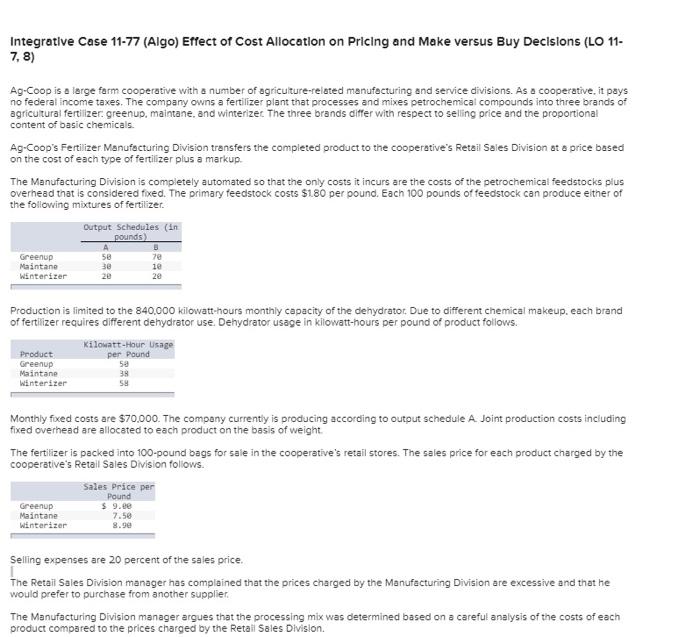Answered step by step
Verified Expert Solution
Question
1 Approved Answer
i posted the required pictures in order i need a-c done for both Integratlve Case 11-77 (Algo) Effect of Cost Allocatlon on Pricing and Make
i posted the required pictures in order i need a-c done for both 



Integratlve Case 11-77 (Algo) Effect of Cost Allocatlon on Pricing and Make versus Buy Declslons (LO 117, 8) Ag-Coop is a large farm cooperative with a number of agricuiture-related manufacturing and service divisions. As a cooperative, it psys no federal income taxes. The company owns a fertilizer plant that processes and mixes petrochemical compounds into three brands of agricuttural fertilizer: greenup, maintane, and winterizet. The three brands differ with respect to selling price and the proportional content of basic chemicals. Ag-Coop's Fertilizer. Manufacturing Division transfers the completed product to the cooperative's Retail Sales Division at a price based on the cost of each type of fertilizer plus a markup. The Manufacturing Division is completely automated so that the only costs it incurs are the costs of the petrochemical feedstocks plus overhead that is considered fixed. The primary feedstock costs $1.80 per pound. Each 100 pounds of feedstock can produce elther of the following mixtures of fertilizer. Production is limited to the 840,000 kilowatt-hours monthly capacity of the dehydratot. Due to different chemical makeup, each brand of fertilizer requires different dehydrator use. Dehydrator usage in kilowatt-hours per pound of product follows. Monthly fixed costs are $70,000. The compony currently is producing according to output schedule A. Joint production costs including fixed overhead are allocated to each product on the basis of weight. The fertilizer is packed into 100 -pound bags for sale in the cooperative's retail stores. The sales price for each product charged by the cooperative's Retall Sales Division follows. Selling expenses are 20 percent of the sales price. The Retail Sales Division manager has complained that the prices charged by the Manufacturing Division are excessive and that he would prefer to purchase from another supplier. The Manufacturing Division manager argues that the processing mix was determined based on a careful analysis of the costs of each product compared to the prices charged by the Retail Sales Division. Requlred: a. Assume that joint production costs including fixed overhead are allocated to each product on the basis of weight. What is the cost per pound of each product, including fored overhed and the feedstock cost of $1.80 per pound, given the current production schedule? b. Assume that joint production costs including fixed overhead are allocated to each product on the basis of net realizable value if sold through the cooperative's Retail Sales Division. What is the allocated cost per pound of each product. given the current production schedule? c. Assume that joint production costs including fixed overhead are allocated to each product on the basis of weight. Calculate the operating profit under both Schedule A and Schedule B. Complete this question by entering your answers in the tabs below. Assume that joint production costs including fixed overhead are allocated to each product on the basis of weight. What is the cost per pound of each product, including fixed overhead and the feedstock cost of $1.60 per pound, given the current production schedule? (Do not round intermediate calculaticns. Round your answer to 2 decimal places.) Integrative Case 11-77 (Statlc) Effect of Cost Allocatlon on Priclng and Make versus Buy Declslons (LO 117,8) Ag-Coop is a large farm cooperative with a number of agriculture-felated manufacturing and service divisions. As a cooperative, it pays no federal income taxes. The company owns a fertilizer plant that processes and mixes petrochemical compounds into three brands of agricultural fertilizer: greenup, maintane, and winterizer. The three brands differ with respect to selling price and the proportiona: content of basic chemicals. Ag-Coop's Fertilizer Manufacturing Division transfers the completed product to the cooperative's Retail Sales Division at a price based on the cost of each type of fertilizer plus a markup. The Manufacturing Division is completely automated so that the only costs it incurs are the costs of the petrochemical feedstocks plus overhead that is considered fixed. The primary feedstock costs $1.50 per pound. Each 100 pounds of feedstock can produce either of the following mixtures of fertilizet. Production is limited to the 750,000 kilowatt-hours monthly capacity of the dehydrator. Due to different chemical makeup, each brand of fertilizer requires different dehydrator use. Dehydrator usage in kilowatt-hours per pound of product follows. Monthly fixed costs are $81,250. The company currently is producing according to output schedule A. Joint production costs including fixed overhead are allocated to each product on the basis of weight. The fertilizer is packed into 100-pound bags for sale in the cooperative's retail stores. The sales price for each product charged by the cooperative's Retail Sales Division foliows. Selling expenses are 20 percent of the sales price. The Retail Sales Division managet has complained that the prices charged by the Manufacturing Division are excessive and that he would prefer to purchase from another supplier. The Manufacturing Division manager argues that the processing mix was determined based on a careful analysis of the costs of each product compared to the prices charged by the Retail Sales Division. Requlred: a. Assume that joint production costs including fixed overnead are allocated to each product on the basis of weight. What is the cost per pound of each product, including fixed overhead and the feedstock cost ot \$1.50 per pound, given the current production schedule? b. Assume that joint production costs including foxed overnead are allocated to each product on the basis of net realizable value if sold through the cooperative's Retal Sales Division. What is the allocated cost per pound of each product, given the current production schedule? c. Assume that joint production costs including fixed overhead are allocated to each product on the basis of weight. Calculate the operating profit under both Schedule A and Schedule B. Complete this question by entering your answers in the tabs below. Assume that joint production costs including ficed overhead are allocated to each product on the basis of weight. What is the cost per pound of each product, including foced overhead and the feedstock cost of $1.50 per pound, given the current production schedule? (Do not round intermediate calculations. Round your answer to 2 decimal places.) 



Step by Step Solution
There are 3 Steps involved in it
Step: 1

Get Instant Access to Expert-Tailored Solutions
See step-by-step solutions with expert insights and AI powered tools for academic success
Step: 2

Step: 3

Ace Your Homework with AI
Get the answers you need in no time with our AI-driven, step-by-step assistance
Get Started


